No matter how frazzled I’m feeling, a visit to Kew Gardens with a friend always sorts me out. It’s impossible to feel anything but a sort of peaceful joy when faced with trees in their new spring green, the bluebell woods, tree reflections in the lakes, and the variety of colours of the flowers in the Broad Walk. So, if you, too, feel in need of some soothing nature, here is what you can see in Kew Gardens in early May.
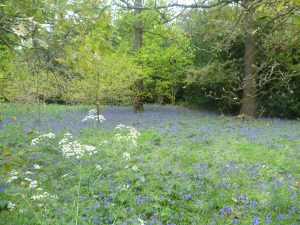
The bluebell woods
The bluebell wood is at its best just now and I wander round breathing in the delicate scent. In some places, the bluebells have been almost ousted by wild garlic but, in other parts of the wood, they co-exist happily with cow parsley, red campion and borage.
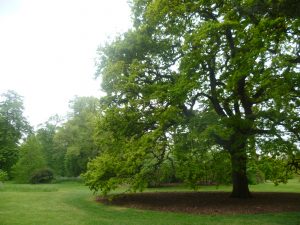
The oak
The trees are now all in leaf, except for the beech, which is still thinking about it and the ash, which is a fraction behind the oak. I remember the rhyme: If oak is out before the ash/ We shall surely have a splash. /If ash is out before the oak/ We shall surely have a soak. We have had a dry April so, this year, it’s accurate.
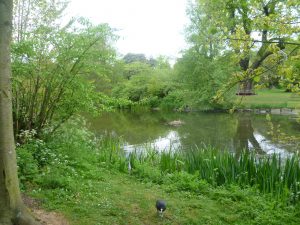
Coot by the lake
There are plenty of geese and ducks around though I can’t see any goslings and cygnets but they may still be tucked away safely on the islands. A lone coot wanders up to where we are standing and has its photograph taken.

The High Walk
This is one of Kew’s new features: a walkway in the sky. It looks wonderful. However, we’ve been wondering round for an hour or so and coffee beckons. One can’t do everything and the High Walk will keep for another day.

Nook for lunch
We have brought sandwiches, so, we find a quiet bench with a temple nearby and enjoy our lunch. Kew belonged to the royal family in the eighteenth century and Queen Charlotte, wife of George III, enjoyed walking here and the various temples date from this time.
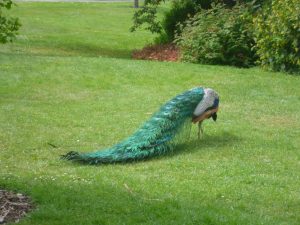
Peacock
A peacock, resplendent in his new plumage, wanders across. Peacocks have a harsh screech and I am tempted to imitate it, hoping that he’ll think either that I’m a rival, or that I’m a peahen, and display his tail feathers, but, alas, he’s not fooled. Probably just as well, as some other people come and sit on a nearby bench.
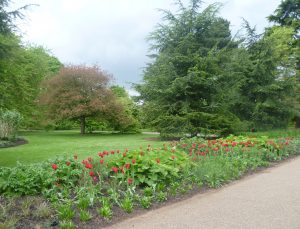
Tulips in the Broad Walk
The Broad Walk borders are the longest double herbaceous borders in the world with a dazzling display of over 30,000 plants. Just now, it’s mainly tulips, with some euphorbias. Nowadays, the planting is much looser than it was was, and the tulips seem to flow naturally towards the trees behind them.
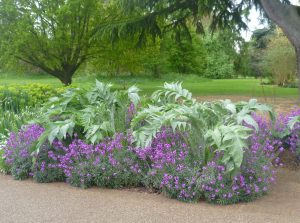
Statement bedding
Occasionally, there is a section of ‘statement bedding’, as with these large architectural acanthus leaves, which look terrific amid the smaller purple flowers.

The urn
It’s impossible to see everything at once, and, after about three hours, it’s time to call it a day. We wander towards the exit at Victoria Gate, stopping to admire the urn in front of the Palm House, looking over the pond, with the rather grandly named Campanile in the background. It was built as a water tower for the plants in the Palm House and is connected to it by a tunnel.
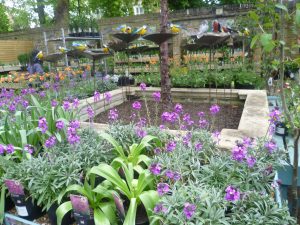
The shop
Finally, there is the shop. Here you can buy plants, gardening tools and books, and the usual tea towels, oven gloves, diaries and so on. The blue-tits on sticks you can just see in the picture are made of metal; so you can plant one in your garden wherever you feel a blue-tit should be.
It’s time to say good-bye to Kew. I hope you have enjoyed this touch of spring.
Elizabeth Hawksley
Please share this page...
Lovely! Gorgeous peacock. Wonderful photographs.
Thank you, Elizabeth. I wish I could have got that peacock to display, though!
What wonderful pictures! The blog is a lovely reminder of the beauties of Kew. I’m always amazed at how peaceful it is there and how the crowds seem to melt away once you’ve walked away from the entrance for a minute or two .
Thank you for your comment, Eleanor. I agree. And I love how different the gardens look every time you visit: different plants, which mean different views; and the trees, particularly the deciduous ones, are changing all the time as they go through blossom-time, full leaf, fruits and cones, and the colours of autumn, and the skeleton trees of winter-time.
It’s all very good for the soul.